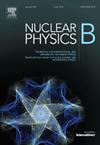Barrow holographic dark energy with varying exponent
IF 2.5
3区 物理与天体物理
Q2 PHYSICS, PARTICLES & FIELDS
引用次数: 0
Abstract
We construct Barrow holographic dark energy with varying exponent. Such an energy-scale-dependent behavior is typical in quantum field theory and quantum gravity under renormalization group considerations, however in the present scenario it has an additional justification, since in realistic cases one expects that Barrow entropy quantum-gravitational effects to be stronger at early times and to smooth out and disappear at late times. We impose specific, redshift-dependent ansätze for the Barrow running exponent, such as the linear, CPL-like, exponential, and trigonometric ones, and we investigate their cosmological behavior. We show that we can recover the standard thermal history of the universe, with the sequence of matter and dark energy epochs, in which the transition from deceleration to acceleration happens at , in agreement with observations. In the most realistic case of hyperbolic tangent ansatz, in which we can easily bound Barrow exponent inside its theoretically determined bounds 0 and 1 for all redshifts, we see that the dark-energy equation-of-state parameter can be quintessence like, or experience the phantom-divide crossing, while in the future it can either tend to the cosmological constant value or start increasing again. All these features reveal that Barrow holographic dark energy with varying exponent is not only theoretically more justified than the standard, constant-exponent case, but it leads to richer cosmological behavior too.
具有变化指数的巴罗全息暗能量
我们构造了变指数的巴罗全息暗能量。这种依赖于能量尺度的行为在量子场论和重正化群考虑下的量子引力中是典型的,然而在目前的情况下,它有一个额外的理由,因为在现实情况下,人们期望巴罗熵量子引力效应在早期更强,在后期变得平滑和消失。我们对巴罗运行指数施加特定的红移相关ansätze,例如线性,类cpld,指数和三角函数,并研究它们的宇宙学行为。我们表明,我们可以恢复宇宙的标准热历史,与物质和暗能量时代的顺序,其中从减速到加速的转变发生在z≈0.65,与观测一致。在最现实的双曲正切ansatz情况下,我们可以很容易地将巴罗指数限制在所有红移的理论确定的界限0和1内,我们看到暗能量状态方程参数可以是典型的,或者经历幻分交叉,而在未来,它可以趋向于宇宙常数值或再次开始增加。所有这些特征都表明,具有变化指数的巴罗全息暗能量不仅在理论上比标准的、恒定指数的情况更合理,而且还导致了更丰富的宇宙行为。
本文章由计算机程序翻译,如有差异,请以英文原文为准。
求助全文
约1分钟内获得全文
求助全文
来源期刊

Nuclear Physics B
物理-物理:粒子与场物理
CiteScore
5.50
自引率
7.10%
发文量
302
审稿时长
1 months
期刊介绍:
Nuclear Physics B focuses on the domain of high energy physics, quantum field theory, statistical systems, and mathematical physics, and includes four main sections: high energy physics - phenomenology, high energy physics - theory, high energy physics - experiment, and quantum field theory, statistical systems, and mathematical physics. The emphasis is on original research papers (Frontiers Articles or Full Length Articles), but Review Articles are also welcome.
 求助内容:
求助内容: 应助结果提醒方式:
应助结果提醒方式:


